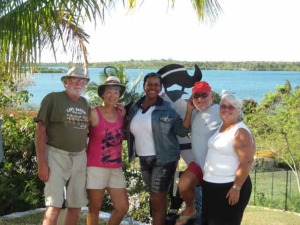“L’Aventura de Dias”or Daily Adventures
Ricardo arrived in a taxi and, for $15 CUC, drove us to Gardalavaca, the nearest town large enough to have a bank. Gardalavaca means “watch the cows” which was named due to the many raids by pirates along these coasts. The bank only had one teller open and the locals were allowed to jump the line. So, to change our money took at least 45 minutes. For $210 Cdn, we received $191.95 CUC. When I asked for $500 CUC from my Visa card, she charged the card in US $, thus giving me a much worse exchange rate. But, as the teller never spoke, I didn’t notice that until just now as I calculated the exchange rate to report here. The next time, we will watch more closely. You must present your passport and Cuban Visa to do any banking and do not have access to your bank accounts. Thus, to save on interest rates, we pre-loaded our Visa card with a positive balance.
From the bank, we wandered, dodging rain storms, to find somewhere for lunch. In a park square, various small vendors had set up shop, selling carvings, small trinkets, leather belts and purses etc.
Once we were fed, it was time to find the “cadeca” which was an office in one of the hotels which would change CUC’s into the national pesos. The money system here can be confusing. In previous years, only tourists had CUC’s and the locals had pesos. Some stores only accepted CUC’s and some just pesos. Now, many of the locals can earn CUC’s and the jobs where they have access to that money are prized. One CUC equals 24 pesos. A doctor in Cuba may earn 30 CUC per month and a maid in a hotel may only earn $5 CUC.
The next day we were up for another adventure and walked several km to the main road. Here we turned toward Holguin and waited at the bus stop. After about 30 minutes, a decrepit bus stopped and, along with some locals, we climbed aboard. A ride was only 1 pesos per person or about 20 cents for all of us.
At Santa Lucia, we climbed out and started to walk. Not far along, we were accosted by a man with a horse and carriage. For 1 peso per person, he agreed to take us to the market. At least that is what we understood. Down paved streets and muddy lanes, the horse led us on, driven by the man who spoke no English and with me, and my broken Spanish, trying to get him to understand. Eventually we arrived at the market square. Here were lots of people and very loud salsa music blaring over huge speakers. Don said ” great, now we will not only be unable to understand what they say but also be unable hear what they say!”. From vendors, we purchased some onions and tomatoes ( about 8 lbs for 5 pesos or 20 cents). Beer was available but you needed to supply your own bottle.
Back into the horse-drawn cart, we went and the driver took us to a local restaurant. For 20 CUC, the four of us ate, the women a chicken dinner while the men had fish. It was accompanied by fried plantain, tomato slices and brown rice. The price also included the 7 beers we drank.
With heavy bags and full tummies, it was time for a cab back to the marina. Tomorrow is Sunday and we plan to do some work around the boat ie repair the jib halyard, put the watermaker to sleep while we are here and write all of these e-mails.
The weather here has been hot and not very windy in the marina. This is a disadvantage as the marina is situated in mangroves and, when the wind dies, the no-see-ums come out. When they are done eating you then the mosquitoes attack. So, we pray for lots of wind to keep both of them at bay.
Tomorrow, Monday, we will rent a car and do some traveling in the interior for several days. We paln to stay at cassa particulares which are a type of bed-and-breakfast. The prices are reasonable and often include dinner. Reports to follow upon our return to the marina.
Hugs and adios,
Heather & Murray

